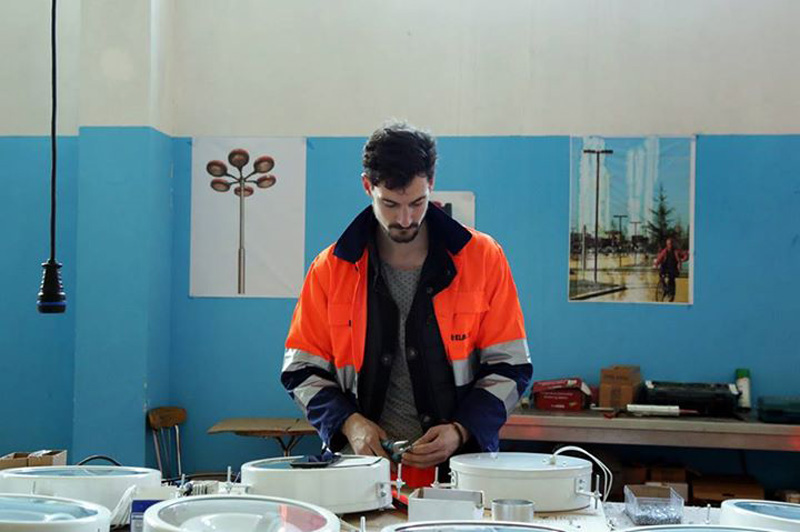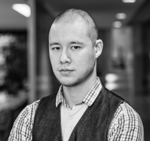The Unofficial View of Tirana (89)

by Vincent W.J. van Gerven Oei
While I was gathering the materials for a follow-up post on my previous report on Albania’s Venice Biennale Pavilion featuring Armando Lulaj (currently in The Guardian‘s Top 5 and in the Top 10 of the Corriere della Sera) I received an email from an attentive reader deviating my interest to more local developments, specifically the current political campaigns for the municipal elections, to be held next month, on June 21. A few weeks ago, both parties announced their candidates for the successor of current mayor of Tirana and Democratic Party (PD) leader Lulzim Basha, who, certain of defeat after a pretty useless four years of delegating his work to deputy mayor Enno Bozdo, bringing nothing more than the destruction of the Tirana train station and endless whining about political obstruction (whining which nonetheless was grounded in reality), will not run for a second term but instead plans to focus on toppling Rama in the national elections of 2017.
Whereas the ruling Socialist Party (PS) of Edi Rama came out with the carefully polished and endlessly ambitious candidate and now former Minister of Social Welfare and Youth Erion Veliaj, the PD chose to nominate the rather obscure and end-of-career politician and gynecologist Halim Kosova, who probably was the only one who didn’t mind losing against Veliaj. Although there are also some independent candidates who may take a few votes here and there, the general opinion of the Tirana public and internationals “in-the-know” is that the municipal elections in Tirana will be a mere formality.
There is much to say about Veliaj’s past as activist in the “Mjaft” movement, his speedy ascent into national politics and the current Rama government, and his failures and successes as Minister of Social Welfare and Youth. However, familiar with my interest in Albanian propaganda, my friendly reader sent me a stack of images from Veliaj’s Facebook account, with the suggestion that I write a short analysis, as I have done in the past with Rama’s photographic propaganda. The first time I met Veliaj was in my former capacity as project assistant in the LGBT project of the Council of Europe. We met in his new office just after his nomination as Minister, outfitted in a supposedly formal and modern style of a bureaucrat-manager, while his official photographer buzzed around us to take snaps of this “meeting with civil society.” At the time I was not particularly impressed by the quality of his court photography, especially compared to Jutta Benzenberg’s magnificent shots of Rama during the election campaign of 2013. However, judging from the images that I received in my inbox, he has developed a distinct media image over the last two years, especially in relation to his own portfolio, which cannot but suggest certain affinities between his style of propaganda and certain tropes from Albanian socialist realism.



Work is insistently depicted as clean, and, whenever possible, sexy and young. Students in a cooking class are dressed in impeccably white outfits, with toned bodies and spotless faces, while hairdressers work in a perfectly clean and blindingly lit shop. A young man working in a lamp workshop casually wears his safety jacket as if it were a fashion item, and even Veliaj himself is seduced by the reflective metal surface of the kitchen top to bake a pancake. Edi Rama would never do such a thing. He inspect and greets, but no longer engages.



The second remarkable aspect is Veliaj’s love for youthfulness and healthy physical activity. Whereas in the past Edi Rama could be seen bonding with former basketball team mates, he now regularly adopts to pose of serious, and somewhat older statesman. Veliaj, on the other hand, can be seen visiting his former high school basketball team, take part in football matches, and shake hand with police officers while biking (careful there!).




Together with these displays of antiseptic labor and physical exercise, comes the majority of the photographic shots on Veliaj’s Facebook page: zoomed-in portrait shots. His photo stream could easily be renamed “Humans of Albania,” and captures non-stop smiling, engaged, serious, fascinated, characteristic, and most of all, attractive faces of whomever attends a Veliaj event. All of them seem to be focused on what he has to say, outside the photographic frame. Attracted to his voice they show their real, beautiful self unconnected to the others surrounding them, without posing, au naturel. All Veliaj’s Albanians are beautiful, and this beauty reflects back on him. Smiling, listening, speaking, waving – enthusiasm is the spirit that drives his politics, it seems.
All of these carefully tuned aspects of Veliaj’s photographic propaganda become much more apparent when contrasted with Halim Kosova’s photography. Although he holds exactly the same type of meetings with exactly the same type of people, they come across as decidedly less positive and exhilarating, owing to the white balance, color scheme, and lenses his much less PR-minded photographer has thought appropriate.




Through the absence of the extreme zoom that characterizes a large part of Veliaj’s propaganda, blurring out all the surrounding faces except for the “concentrated one,” the images of Kosova’s campaign seem much flatter. Veliaj’s meetings never seem crowded; everyone claims their own, individual, respected space in the face of the new leader. In Kosova’s meetings, people are cluttered together, sweating, feeling each other’s bodily presence. Kosova speaks to disgruntled and skeptical masses; Veliaj to enlightened individuals. Kosova’s photography is perhaps more journalistic, but therefore also insistently portrays him in a different light. Whereas Veliaj is consistently bright and lit up, as if the white balance revolved around his skin tone, Kosova appears under a dazzling array of lightings, which contributes to an image of uncertainty, discomfort, and unclarity. In his photos, Veliaj is never out of focus, unless there for example a cute child on the foreground, and he always faces the camera, at most en profil. Kosova, on the other hand, is often photographed from the back, blurry, or out of focus, obstructing contact, through the image, with the viewer.
So what can we conclude from this short inspection of the photographic propaganda of the two main contenders in the upcoming Tirana municipal elections? First that the Kosova campaign has not for one moment thought about visual representation; even Lulzim Basha’s attempts to portray enthusiastic masses (an important image trope on his Facebook) looks more deliberate. And second that the two years in governmental office have allowed to Veliaj to experiment with photography to such an extent that he now seems to have found his specific “brand,” close to but definitely different from Rama’s photographic propaganda: clean, young, active, individualistic, hands-on. He is going to win, and he knows it – because all the people are winning in his image. Moreover, he seems decided to win beyond his four-year term as mayor of Tirana: this is the photography of a crown prince.
About the Author:

Vincent W.J. van Gerven Oei is a philologist, director of project bureau for the arts and humanities The Department of Eagles, and runs multilingual publishing house Uitgeverij. For Berfrois he writes a regular blog on the state and concept of Albania, where he lives and works most of the time.









